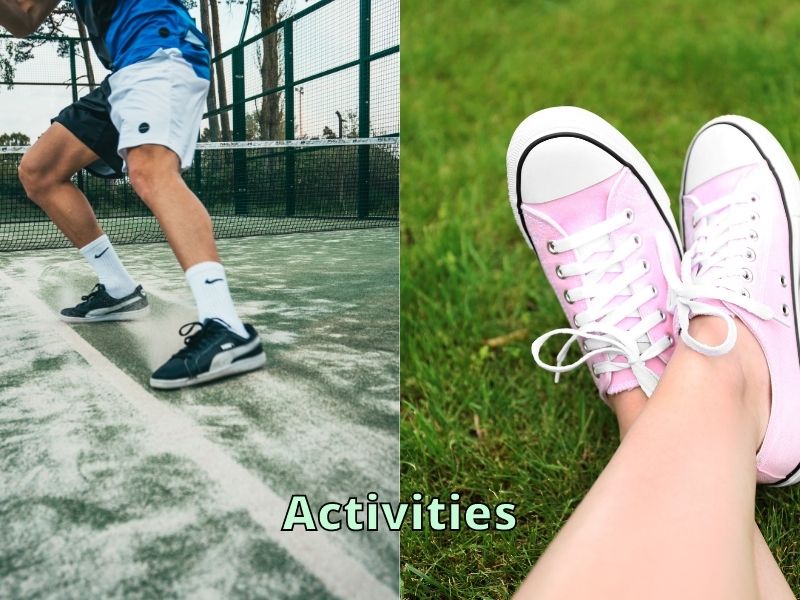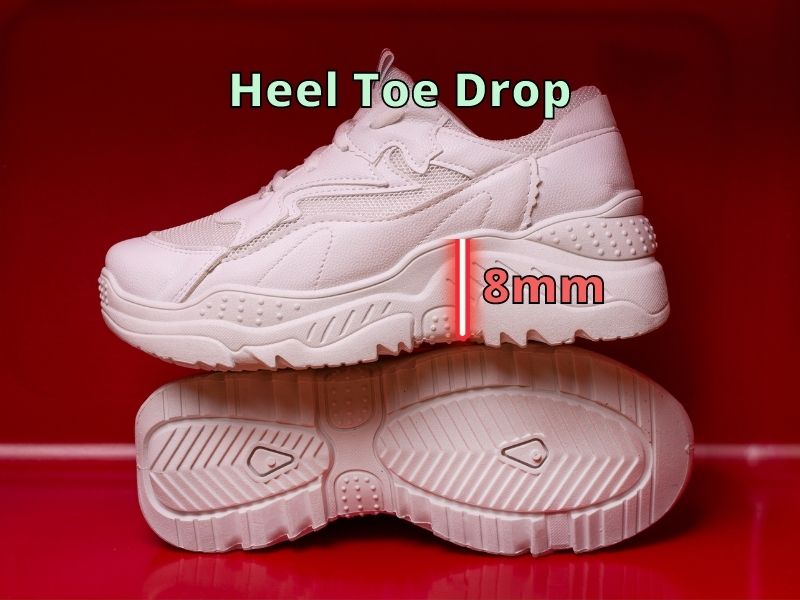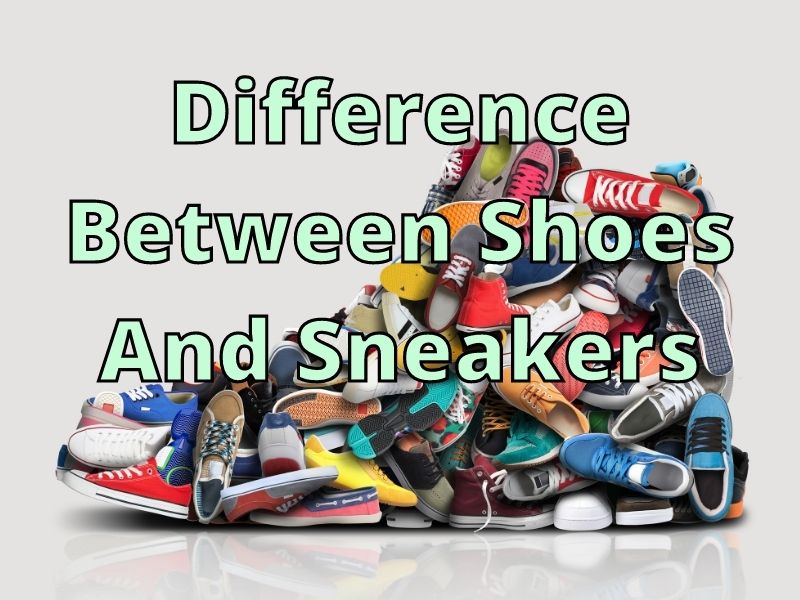You might have heard people call shoes and sneakers interchangeably. Unfortunately, shoes and sneakers are almost the same for most people, which is not correct! So, what is the difference between shoes and sneakers?
Shoes are a general term for most all footware, while sneakers are a general term for active footwear. Shoes and sneakers can mean the same thing, but sneaker refers to the more specific type of shoe that people often use for athletic activities.
Shoes and sneakers are both designed to protect your feet, keep them warm and comfortable and support them. However, there are still so many differences between them in terms of material, activities, purposes, etc. first, let’s briefly discuss what shoes and sneakers are?
What Are Shoes?
In simple terms, shoes are the accessory we wear to provide comfort and warmth to their feet.
Depending on their type and design, shoes are made from various materials, including leather, fabric, polyurethane, rubber, and nylon. These materials are used to make the upper and bottom parts of a shoe.
There are many different types of shoes, such as running shoes, training shoes, athlete shoes, dress shoes, formal shoes, casual shoes, sandals, boots, and sports shoes. Each of them serves a different purpose.
For example, shoes with soft soles are usually casual and daily wear. In contrast, shoes with hard soles are used by athletes to resist wear and tear.
What Are Sneakers?
Sneakers are pretty popular these days. Sneakers are a kind of footwear with flexible soles. The upper of sneakers are made with fabric or synthetic material, and the soles are made with rubber material.
Sneakers are extremely comfortable footwear mostly used for walking, sports activities, everyday use, and casual wear. The name sneaker refers to how quiet the rubber soles are compared to the hard leather soles of shoes.
A wide range of sneakers is available in the market. However, it is incorrect to call all rubber-soled shoe sneakers.
Material Difference Between Shoes and Sneakers

The main difference between shoes and sneakers is the material they are made of. Generally, many shoes are made from synthetic polyurethane, nylon, porous, and mesh fabric. These are the fabrics to construct the top and bottom of the shoe.
These materials are used to make your shoe lightweight, breathable and waterproof. In addition, they are easy to clean and maintain and allow your shoes to provide comfort and warmth.
However, sneakers are usually made with rubber soles, making them long-lasting and comfortable. Also, the soles of sneakers are incredibly soft and don’t make any noise.
The uppers of sneakers are usually made from synthetic materials or canvas to make them lightweight.
Activities Difference Between Shoes and Sneakers

Another difference between shoes and sneakers is the activities they are used for. Shoes can be used for numerous activities.
You can wear shoes for activities like walking, running, and training. Similarly, sneakers can be used for jogging and casual wear. There are several kinds of shoes like running shoes, sports shoes, tennis shoes, and they all are designed and used for their specific activities.
Sneakers are not suitable for training and other sports-related activities. Instead, they are generally designed for everyday use and casual wear.
Purpose Difference Between Shoes and Sneakers

While some people wear shoes for style and comfort, others wear them for stability and traction. Probably this is why there are so many shoes available in the market.
Shoes are strong enough to serve different purposes such as jogging, running, and training. Different shoes are designed for different purposes; for example, running shoes are specifically designed for running, tennis shoes are designed for playing tennis, etc.
The right shoes provide comfort, stability, and traction. Additionally, they have rubber padding to give extra cushioning and support as you move.
On the other hand, sneakers are plain shoes with a canvas top and soft rubber soles. They are more comfortable and are suitable for casual use since they are incredibly comfortable and flexible, so you can use them for walking and jogging purposes.
Sneakers come in many different styles and designs. Still, most of them are not suitable for hard use like training and sports-related activities. Sneakers do not provide enough support, traction, and shock absorption.

Comfort Difference Between Shoes and Sneakers
Another important factor to consider when comparing shoes and sneakers is comfort.
Shoes provide a wide range of comfort for activities such as running and training, but only good comfort if you choose the best ones. Otherwise, you’ll end up with heavy footwear that is both uncomfortable and painful.
On the contrary, whether expensive or cheap, sneakers generally provide good all around comfort. They don’t feel heavy at all. You can wear them for everyday use as well as for walking.
Cushioning Difference Between Shoes and Sneakers
Cushioning is the ability of footwear to absorb the force of impact as you hit the ground while running. Without proper cushioning, you may risk severe injuries.
Cushioning is crucial for any kind of footwear, whether shoes or sneakers, since it prevents discomfort, pain, injuries, and plantar fasciitis.
When it comes to shoes, you get proper cushioning because shoes’ soles may be constructed with thick and comfortable materials. So, you don’t have to worry about getting injuries, pain, or any kind of discomfort.
However, sneakers may not offer much cushioning. That’s maybe because sneakers have flexible rubber soles. However, some brands do offer proper cushioning in some sneaker models.
But for sneakers, less cushioning is needed to keep them lightweight. Therefore, I wouldn’t recommend wearing sneakers for running.
When walking, you hit the ground 1.5 times your body weight, but it goes up to four times your body as you run. So, you need extra padded cushioning to maximize your running comfort level.
With this extra padded cushioning, you can run for miles without trouble, injuries, or pain. You need a good amount of cushioning in your footwear to maximize your performance.
Motion Control Difference Between Shoes and Sneakers
Motion control is another key difference between shoes and sneakers. Motion control refers to the amount of control footwear provides to your feet while you wear them.
Therefore, you need reasonable motion control for activities like running. But as far as casual use is concerned, motion control can be ignored.
If you compare motion control in shoes and sneakers, you can’t make a quick decision since it depends largely on the manufacturer.
High-quality running shoes that are specifically designed for running offer good motion control. But regular shoes do not have sturdy ridges, so it’s hard to stop when running in these shoes.
On the other hand, sneakers for casual use have a motion control feature but not as much as running shoes. Furthermore, compared to normal shoes, sneakers have high-quality rubber soles that feature ridges for better control. As a result, they make any task easier without causing any issues.
Stability Difference Between Shoes and Sneakers
Gripping ability is another crucial factor for footwear. Gripping includes how the upper of your footwear provides a secure fit and feel. The grip and stability of your footwear come in the form of laces.
Some shoes have laces, some have elastic, and some have straps. Though shoes with elastics and straps may be strong, you can’t expect the same level of stability from every shoe. Also, these shoes may lack a secure fit, and they may loosen with time.
As far as sneakers are concerned, they mostly have laces in the upper part, so you get excellent stability regardless of their design.
Structure Difference Between Shoes and Sneakers

The structure is the most prominent visual difference between shoes and sneakers. First, you must understand that different shoes are designed to serve different purposes, as mentioned above. Therefore, they are structured in different ways.
Shoes are usually sturdier and more durable than sneakers since they need to provide you with proper cushioning and support for different activities and multidirectional movements.
Shoes are structurally unique and different from each other. They are generally wider than sneakers. Some shoes have extra height to provide extra padding for running,
Conversely, sneakers may have a narrow and tall structure that gives feet more room to move and breathe. This structure also makes them comfortable to use.
Durability Difference Between Shoes and Sneakers
Since many shoes are made of polyurethane, they are far more durable than sneakers. Polyurethane is a very sturdy and durable material. In addition, this material can handle high-pressure impacts and sharp objects.
Therefore, you can wear shoes even on rough terrains without worrying. They just need to have durable outsoles!
On the other hand, the outsoles of sneakers are generally made with rubber which is a very lightweight material. So, you can’t expect much durability from sneakers since the outsoles aren’t strong enough.
Unfortunately, sneakers may noy withstand too much pressure. Also, hard and sharp objects can easily pierce these soles. So don’t even think about wearing sneakers on rough terrain.
Heel-Toe Drop Difference Between Shoes and Sneakers

The heel-toe drop is essential in understanding the difference between shoes and sneakers. The heel-toe drop is the height difference between the heel and toe.
When you run, your energy is transferred from the back of the foot to the front. During landing, your heels absorb most of the force then transfer the energy to the balls of your feet as you push forward. Therefore, shoes need to have plenty of cushioning in the heel.
Shoes generally have 8mm to 12mm. It means their heel height is larger than the toe. This will ensure your shoes have maximum stability and flexibility.
First, the front of the foot is touched, so shoes are designed with a sufficient heel height. This heel height helps you take all your next steps with ease.
Sneakers usually have a heel-toe drop between 6mm and 12mm. Sneakers are designed to provide frontal support for the feet. They don’t offer lateral support.
Weight Difference Between Shoes and Sneakers
Most of the properties depend on the material used in footwear, including weight. Therefore, the material is one of the main factors determining weight. Since shoes are generally made of synthetic materials, they are heavier than sneakers. Also, the wide outsoles of shoes make them very heavy.
Whereas sneakers are usually made of lighter fabrics, so they are lightweight. Also, lightweight is a primary requirement for sneakers.
Flexibility Difference Between Shoes and Sneakers
Flexibility is crucial for running shoes. All high-intensity workouts such as jogging, running, and gym require shoes that provide excellent flexibility.
If you don’t wear flexible shoes for these activities, you may end up having foot injuries and pain.
Both running shoes and sneakers provide you with good flexibility. Since sneakers are made with rubber soles and canvas uppers, they provide excellent flexibility.
Here is a small video that may help you deeply understand the difference between shoes and sneakers.
An Overview of The Differences Between Shoes and Sneakers
Below is a table that may help you understand the major differences between shoes and sneakers, from their materials to their designs.
| Differences | Shoes | Sneakers |
|---|---|---|
| Material | Leather, mesh fabric, polyurethane, rubber, nylon, and porous | Mesh fabric, canvas, rubber |
| Activities | Walking, running, training, jogging, and sports | Walking, jogging, and casual wear |
| Purpose | Serve multiple purposes | Everyday use and casual wear |
| Comfort | Adequate comfort | Maximum comfort |
| Cushioning | Proper cushioning | Do not offer much cushioning |
| Stability | Different levels of stability depending upon the design | Excellent stability due to laces |
| Structure | Wider with extra height | Narrow and tall |
| Durability | More durable | Less durable |
| Heel-Toe Drop | 8mm to 12mm | 6mm and 12mm |
| Weight | Heavier | Lightweight |
| Flexibility | Good flexibility | Excellent flexibility |
Thanks for visiting helpshoe.com
References

